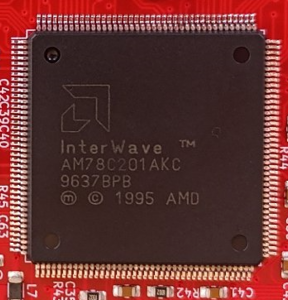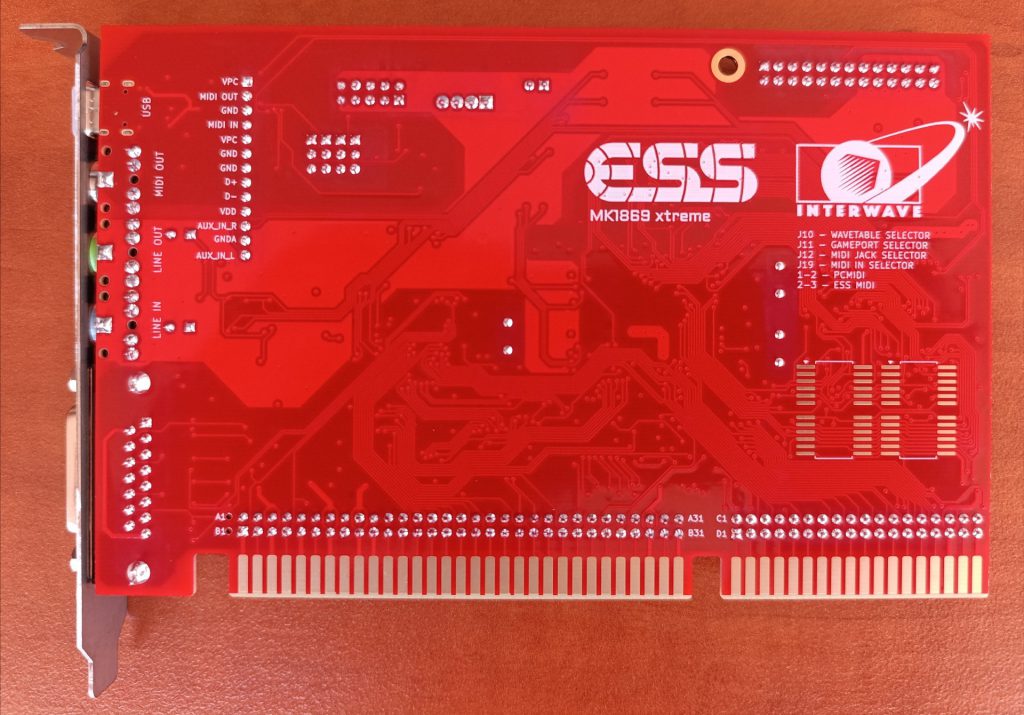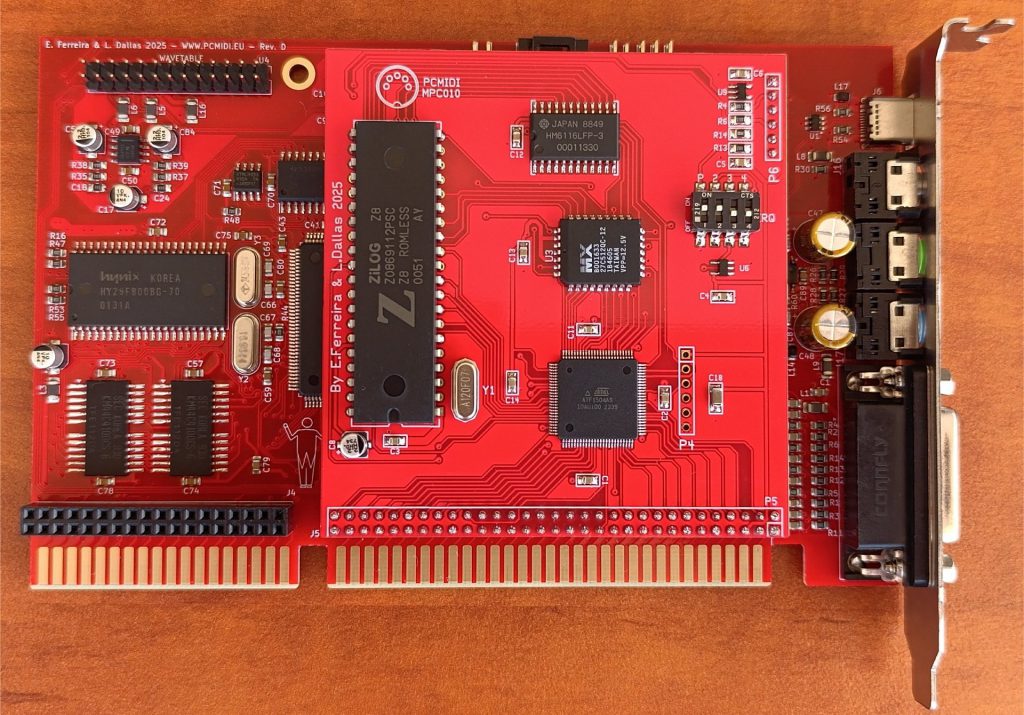This PCMIDI team is at it again with their latest ISA soundcard, the MK1869 XTREME. That is a soundcard based off the previous iteration of their MK1869, however this cards extreme feature is the addition of the AMD Interwave Audio chip. This chip was the backbone and base of the later model revisions of the Gravis Ultrasound (GUS) and in particular the Gravis Ultrasound Xtreme (got to love 90’s extreme marketing). Which is the inspiration for this new soundcard from PCMIDI. This soundcard run is also similar to the Orpheus II soundcard that also included the AMD Interwave Audio chip. Though it comes in at a cheaper price point while still utilizing a high quality compact PCB design.


The overall features of this soundcard are built around two onboard audio chips. The first one being the Electronic Speech Systems (ESS)1869 ESS AudioDrive sometimes known as “ES Enhanced” or ESFM. ESFM is ESS’ form on Frequency Modulation or FM Synthesis and much like Yamaha’s famed FM line of OPN and OPL chips. The likes of which powered the SEGA MEGA DRIVE(Genesis), SNK’s NEO GEO, or PC soundcards like Adlib and Creative Soundblasters.
The ESFM offered a competing yet comparable Adlib compatible sound chip, while also offering a unique take on the FM music experience. When the ESS AudioDrive was released several game publishers made efforts to support this “ES Enhanced” mode of FM and a list of supported games can be found on DOS Days as well as more information and background on ESS in the “links” section. Below is a bulleted snippet from PCMIDI’s web page:
Distinctive Characteristics
• AdLib, Sound Blaster and Sound Blaster PRO compatible for DOS (with SB ADPCM support)
• Windows drivers with up to 48khz sampling rate
• High-quality, OPL3 superset ESFM music synthesizer
• MIDI port – compatible with MPU-401 UART mode
• Integrated Spatializer 3-D audio effects processor
• Integrated dual game port
• 16-bit stereo ADC and DAC
• Programmable independent sample rates from 4 kHz to 48.0 kHz for record and playback
• Full-Duplex operation for simultaneous record and playback
• Drivers for Microsoft® Windows™ 3.1x , 9x, ME, NT4 and IBM OS/2
• Meets PC 97/PC 98 and WHQL specifications
The second onboard chip is the AMD Interwave Audio which supports native Gravis Ultrasound playback. The Gravis Ultrasound from Advanced Gravis and Forte Technologies was a unique soundcard that burst into the market in the early 90’s. It offered an onboard built in wavetable capability as well as the ability to process its audio samples separate from the computers CPU (Central Processing Unit). Gravis Ultrasounds could utilize sound patches and many iterations of their soundcards had expandable memory to increase and enhance the quality of sampled audio playback.
The GUS was a powerhouse in audio playback and popular with the PC Demo Scene however it lacked in overall compatibility with Adlib/OPL based games of which were many in the DOS gaming era. This issue is addressed by partnering with the ESS AudioDrive and the marriage between the two is nearly perfect. The MK1869 XTREME comes with 4 Megabytes (MB) of onboard Random Access Memory (RAM) built in and is pre loaded with the standard 1mb Interwave Read Only Memory (ROM) bank. This card can be further expanded with two additional pads located on the rear of the card which could allow users to solder in two more DRAM chips for a max onboard RAM of 8MB. If you want to learn more on the Gravis Ultrasound links to Classic Gaming Quarterly’s TheGravisUltrasound.com and DOS Days Gravis product page will be linked below. Here is another snippet from PCMIDI’s site below:
Distinctive Characteristics
• 32-voice stereo wavetable synthesizer
• Integrated effects processor
• Up to 32 channels of digital mixing
• Stereo 16-bit audiophile codec with IMA ADPCM 4:1 compression/decompression
• MPC-compliant analog mixer
• Supports multiple standards:
— MPU-401
— MPC2, MPC3
— General MIDI
— Microsoft® Windows®95, DirectSound™*
— Windows 3.x API, Win32 API*
— Miles AIL API*
— HMI SOS API*
— UltraSound*
— Lucas Arts iMUSE API*
* Appropriate software drivers required

The MK1869 XTREME has a few other features which should be noted for including a wavetable header pins supporting addon daughterboards. The wavetable header can further enhance this cards General MIDI music output options like utilizing daughterboard designs offered from Serdashop. Like the Dreamblaster X2GS as an example giving Roland SC-55 licensed soundbank quality playback. The other neat feature is the additional header pins for attaching a PCMIDI MPU card directly to the soundcard itself. The MPU card features the abilities to interface with a Roland MT-32 MIDI sound module in both UART or Intelligent mode. Normally PCMIDI offers their PCMIDI MPU ptoduct as a separate ISA slotable card. However the team took the opportunity to design the MK1869 in a way to get the added MPU capabilities without sacrificing an ISA slot. Which is fantastic for systems with limited or only one available ISA slot.

The MK1869 XTREME pricing starts at €250 with optional extras including an addon PCMIDI MPU board and wavetable daughterboards like those offered from Serdashop. The PCMIDI MPU board will be €70 and two wavetable daughterboards options will be the Dreamblaster X2GS at €60 and X16GS at €100. A preorder page is available and pricing deposites including a partial deposit is explained. Further information and links to the product page, drivers, and addition background to these audio chips down bellow.
LINKS:
PCMIDI’s Product Page | https://pcmidi.eu/xtreme.html
VOGONS Product Thread | https://www.vogons.org/viewtopic.php?t=102417
DOSDays ESS Information | https://dosdays.co.uk/topics/Manufacturers/ess.php
DOSDays Gravis Information | https://dosdays.co.uk/topics/Manufacturers/gravis.php
Serdashop MIDI Store | https://www.serdashop.com/MIDI
The Gravis Ultrasound CGQ | http://www.gravisultrasound.com/
